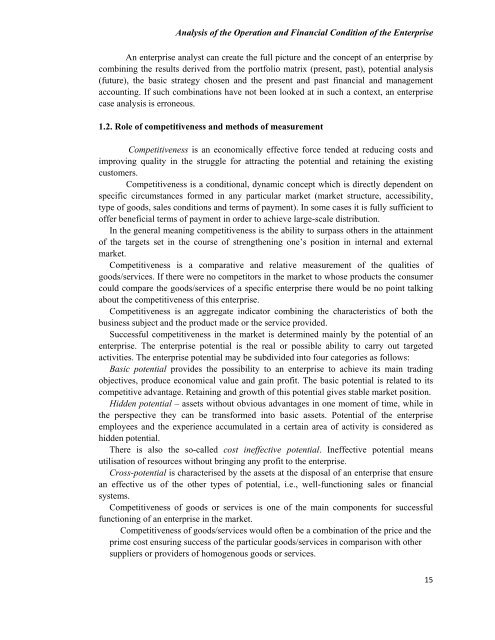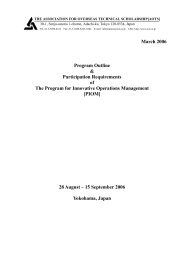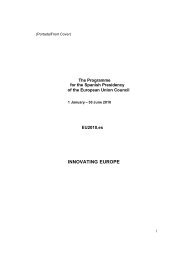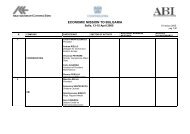Analysis of the Operation and Financial Condition of the Enterprise
Analysis of the Operation and Financial Condition of the Enterprise
Analysis of the Operation and Financial Condition of the Enterprise
You also want an ePaper? Increase the reach of your titles
YUMPU automatically turns print PDFs into web optimized ePapers that Google loves.
<strong>Analysis</strong> <strong>of</strong> <strong>the</strong> <strong>Operation</strong> <strong>and</strong> <strong>Financial</strong> <strong>Condition</strong> <strong>of</strong> <strong>the</strong> <strong>Enterprise</strong>An enterprise analyst can create <strong>the</strong> full picture <strong>and</strong> <strong>the</strong> concept <strong>of</strong> an enterprise bycombining <strong>the</strong> results derived from <strong>the</strong> portfolio matrix (present, past), potential analysis(future), <strong>the</strong> basic strategy chosen <strong>and</strong> <strong>the</strong> present <strong>and</strong> past financial <strong>and</strong> managementaccounting. If such combinations have not been looked at in such a context, an enterprisecase analysis is erroneous.1.2. Role <strong>of</strong> competitiveness <strong>and</strong> methods <strong>of</strong> measurementCompetitiveness is an economically effective force tended at reducing costs <strong>and</strong>improving quality in <strong>the</strong> struggle for attracting <strong>the</strong> potential <strong>and</strong> retaining <strong>the</strong> existingcustomers.Competitiveness is a conditional, dynamic concept which is directly dependent onspecific circumstances formed in any particular market (market structure, accessibility,type <strong>of</strong> goods, sales conditions <strong>and</strong> terms <strong>of</strong> payment). In some cases it is fully sufficient to<strong>of</strong>fer beneficial terms <strong>of</strong> payment in order to achieve large-scale distribution.In <strong>the</strong> general meaning competitiveness is <strong>the</strong> ability to surpass o<strong>the</strong>rs in <strong>the</strong> attainment<strong>of</strong> <strong>the</strong> targets set in <strong>the</strong> course <strong>of</strong> streng<strong>the</strong>ning one’s position in internal <strong>and</strong> externalmarket.Competitiveness is a comparative <strong>and</strong> relative measurement <strong>of</strong> <strong>the</strong> qualities <strong>of</strong>goods/services. If <strong>the</strong>re were no competitors in <strong>the</strong> market to whose products <strong>the</strong> consumercould compare <strong>the</strong> goods/services <strong>of</strong> a specific enterprise <strong>the</strong>re would be no point talkingabout <strong>the</strong> competitiveness <strong>of</strong> this enterprise.Competitiveness is an aggregate indicator combining <strong>the</strong> characteristics <strong>of</strong> both <strong>the</strong>business subject <strong>and</strong> <strong>the</strong> product made or <strong>the</strong> service provided.Successful competitiveness in <strong>the</strong> market is determined mainly by <strong>the</strong> potential <strong>of</strong> anenterprise. The enterprise potential is <strong>the</strong> real or possible ability to carry out targetedactivities. The enterprise potential may be subdivided into four categories as follows:Basic potential provides <strong>the</strong> possibility to an enterprise to achieve its main tradingobjectives, produce economical value <strong>and</strong> gain pr<strong>of</strong>it. The basic potential is related to itscompetitive advantage. Retaining <strong>and</strong> growth <strong>of</strong> this potential gives stable market position.Hidden potential – assets without obvious advantages in one moment <strong>of</strong> time, while in<strong>the</strong> perspective <strong>the</strong>y can be transformed into basic assets. Potential <strong>of</strong> <strong>the</strong> enterpriseemployees <strong>and</strong> <strong>the</strong> experience accumulated in a certain area <strong>of</strong> activity is considered ashidden potential.There is also <strong>the</strong> so-called cost ineffective potential. Ineffective potential meansutilisation <strong>of</strong> resources without bringing any pr<strong>of</strong>it to <strong>the</strong> enterprise.Cross-potential is characterised by <strong>the</strong> assets at <strong>the</strong> disposal <strong>of</strong> an enterprise that ensurean effective us <strong>of</strong> <strong>the</strong> o<strong>the</strong>r types <strong>of</strong> potential, i.e., well-functioning sales or financialsystems.Competitiveness <strong>of</strong> goods or services is one <strong>of</strong> <strong>the</strong> main components for successfulfunctioning <strong>of</strong> an enterprise in <strong>the</strong> market.Competitiveness <strong>of</strong> goods/services would <strong>of</strong>ten be a combination <strong>of</strong> <strong>the</strong> price <strong>and</strong> <strong>the</strong>prime cost ensuring success <strong>of</strong> <strong>the</strong> particular goods/services in comparison with o<strong>the</strong>rsuppliers or providers <strong>of</strong> homogenous goods or services.15
















